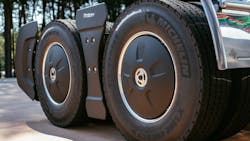Counteracting unintended consequences of aerodynamic devices
Aerodynamic devices are tools fleets can use to reduce drag on their vehicles and increase fuel efficiency. But before fleets decide to add these devices, it is important they know some of the unintended additional maintenance that can be caused by aerodynamic devices. The Technology & Maintenance Council’s (TMC) Recommended Practice (RP) 1110 – Inspection and Maintenance Recommendations for Aerodynamic Devices – covers four areas on a truck that could be impacted by the addition of an aerodynamic device.
Drivetrains
The problem
Vehicles using aerodynamic products that obstruct air flow underneath the vehicle could direct air away from certain components that rely on it for cooling. This could increase the temperature of components such as the transmission, for example, reducing the lifespan of the gear, synchronizer, bearing, and seal.
TMC’s Recommendation
Many transmission suppliers recommend gear oils not be used in transmissions, so fleets should try using SAE 50 weight engine oils in the transmission instead – nothing more viscous. Additionally, fleets should consider spec’ing oil coolers on tractors equipped with engines over 350 horsepower, as well as make sure the coolers are installed where they can work properly. Lastly, choose the appropriate viscosity grade gear oil or synthetic lube oil in drive axles.
Brakes
The problem
With less wind resistance helping to slow it down, the brakes on a vehicle with aerodynamic devices absorb more energy, meaning there are more brake applications for the same amount of retardation and a higher brake operating temperature. Additionally, if the aerodynamic device reduces air flow over the brakes, this can shorten the life of brake components.
TMC’s Recommendation
Increased inspection of the brakes, as well as the potential adoption of retarders on very “aerodynamically clean” tractors.
Cab structure
The problem
When installing aerodynamic devices, any places where the attachment hardware goes through the cab skin are potential areas for corrosion development. In time, these areas could also present fatigue cracks.
TMC’s Recommendation
Frequent visual inspections will help prevent major repair work from being required. Look for hairline cracks and corrosion at mounting bolt locations and repair any that are found according to the manufacturer’s instructions for that cab material.
Refrigeration units
The problem
Certain aerodynamic devices – full cab, roof-mounted air fairings and cab extenders particularly – can cause loss of refrigeration unit cooling because of heat drawn from the tractor. Occasionally, this will lead to a total unit shutdown.
TMC’s Recommendation
Managing the airflow in and around the refrigeration unit can improve its efficiency. For fleets in hot or humid areas, drivers should pay close attention to the vehicle’s temperature. Additionally, fleets may need to install thermometers outside the trailer so they can be read during walk-around inspections or deliveries. TMC also recommends simple recording thermometers be installed on the front face of the trailer to track the temperature between the tractor and trailer. It should be noted that if that temperature reaches 100 degrees F, reduced cooling efficiency will result.
This article originally appeared on Fleet Maintenance.
About the Author
Emily Markham
Assistant Editor | Vehicle Repair Group
Emily Markham is an assistant editor for the Vehicle Repair Group.
With an education based in writing and editing, Markham uses her knowledge to assist with the creation of content for Endeavor Business Media Vehicle Repair Group’s publications—Fleet Maintenance, Professional Tool & Equipment News (PTEN), and Professional Distributor—as well as their website, VehicleServicePros.com.

